
The Joker is a supervillain appearing in American comic books published by DC Comics. The character was created by Bill Finger, Bob Kane, and Jerry Robinson, and first appeared in the debut issue of the comic book Batman on April 25, 1940. Credit for the Joker's creation is disputed; Kane and Robinson claimed responsibility for the Joker's design while acknowledging Finger's writing contribution. Although the Joker was planned to be killed off during his initial appearance, he was spared by editorial intervention, allowing the character to endure as the archenemy of the superhero Batman.
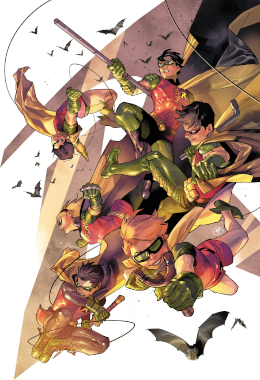
Robin is the alias of several superheroes appearing in American comic books published by DC Comics. The character was originally created by Bob Kane, Bill Finger, and Jerry Robinson, to serve as a junior counterpart and the sidekick to the superhero Batman. As a team, Batman and Robin have commonly been referred to as the Caped Crusaders and the Dynamic Duo. The character's first incarnation, Dick Grayson, debuted in Detective Comics #38. Conceived as a way to attract young readership, Robin garnered overwhelmingly positive critical reception, doubling the sales of the Batman titles. Robin's early adventures included Star Spangled Comics #65–130 (1947–1952), the character's first solo feature. He made regular appearances in Batman-related comic books and other DC Comics publications from 1940 through the early 1980s, until the character set aside the Robin identity and became the independent superhero Nightwing.

The Elizabeth Arkham Asylum for the Criminally Insane, commonly referred to as Arkham Asylum, is a fictional psychiatric hospital/prison, appearing in American comic books published by DC Comics, commonly in stories featuring the superhero Batman. It first appeared in Batman #258, written by Dennis O'Neil with art by Irv Novick. The asylum serves as a (forensic) psychiatric hospital for the Gotham City area, housing patients who are criminally insane, as well as select prisoners with unusual medical requirements that are beyond a conventional prison's ability to accommodate. Its high-profile patients are often members of Batman's rogues gallery.

Alan Grant was a British comic book writer known for writing Judge Dredd in 2000 AD as well as various Batman titles from the late 1980s to the early 2000s. He was the co-creator of the characters Anarky, Victor Zsasz, and the Ventriloquist.
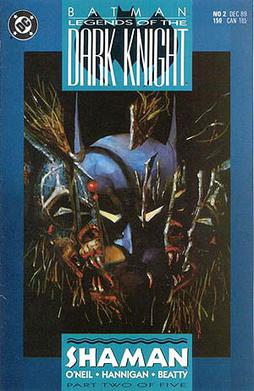
Batman: Legends of the Dark Knight, often simply called Legends of the Dark Knight, is the name of several DC comic books featuring Batman. The original series launched in 1989 as the third major monthly Batman title, following the popularity of Tim Burton's 1989 film Batman. Many of the stories follow the tone of Frank Miller's Batman: Year One. The series differed from other Batman titles of the time. The creative team rotated with every story arc and the stories stood alone, unlike the inter-connected nature of other Batman comics. Initially the title ran stories contained to five issues, often with more mature topics and sensibilities than the other Batman titles. After issue #20, the number of issues for each story began to vary and occasionally tied into crossover events.
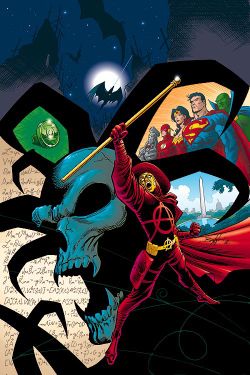
Anarky is an anti-hero appearing in American comic books published by DC Comics. Co-created by Alan Grant and Norm Breyfogle, he first appeared in Detective Comics #608, as an adversary of Batman. Anarky is introduced as Lonnie Machin, a child prodigy with knowledge of radical philosophy and driven to overthrow governments to improve social conditions. Stories revolving around Anarky often focus on political and philosophical themes. The character, who is named after the philosophy of anarchism, primarily espouses anti-statism and attacks capitalism; however, multiple social issues have been addressed through the character, including environmentalism, antimilitarism, economic inequality, and political corruption. Inspired by multiple sources, early stories featuring the character often included homages to political and philosophical texts, and referenced anarchist philosophers and theorists. The inspiration for the creation of the character and its early development was based in Grant's personal interest in anti-authoritarian philosophy and politics. However, when Grant himself transitioned to the philosophy of Neo-Tech developed by Frank R. Wallace, he shifted the focus of Anarky from a vehicle for social anarchism and then libertarian socialism, with an emphasis on wealth redistribution and critique of Capitalism, to themes of individualism and personal reflexions on the nature of consciousness.
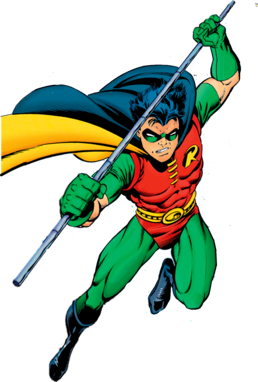
Timothy Jackson "Tim" Drake is a superhero appearing in American comic books published by DC Comics, commonly in association with the superhero Batman. Created by Marv Wolfman and Pat Broderick, he first appeared in Batman #436 as the third character to assume the role of Batman's crime-fighting partner and sidekick Robin. Following the events of Batman: Battle for the Cowl in 2009, Drake adopted the identity of Red Robin. In 2019, Tim returned to his original Robin persona and briefly used the mononym "Drake".
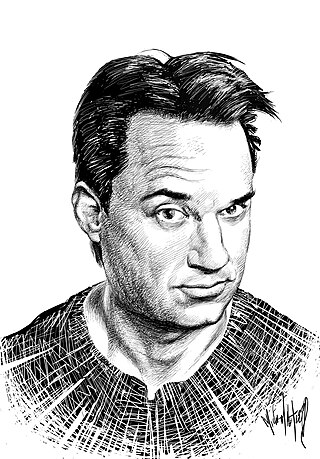
Norman Keith Breyfogle was an American artist, best known for his comic book art on DC Comics' Batman franchise from 1987 to 1995. During this time, he co-created the villains Ventriloquist and Ratcatcher with writers Alan Grant and John Wagner, and the characters Anarky, Jeremiah Arkham, Victor Zsasz, and Amygdala with Grant alone. He co-created with writers Gerard Jones and Len Strazewski the Malibu Comics Ultraverse flagship hero Prime, and both wrote and drew the Malibu-published series featuring his original character Metaphysique.
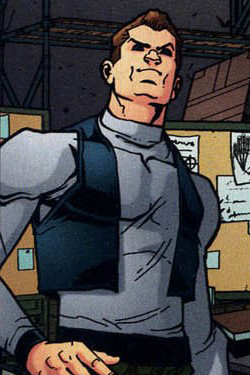
General is a fictional character appearing in American comic books published by DC Comics. Created by Chuck Dixon as an adversary of Batman, the character first appeared in Detective Comics #654, published in December 1992. Named for the character's gimmick for military strategy and prowess with small arms, stories involving the character often include historic military references and themes.

Batman is an ongoing American comic book series featuring the DC Comics superhero Batman as its main protagonist. The character, created by Bill Finger and Bob Kane, first appeared in Detective Comics #27. Batman proved to be so popular that a self-titled ongoing comic book series began publication with a cover date of spring 1940. It was first advertised in early April 1940, one month after the first appearance of his new sidekick, Robin the Boy Wonder. Batman comics have proven to be popular since the 1940s.
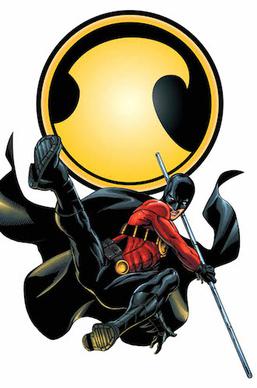
Red Robin is a name that has been used by several superheroes appearing in American comic books published by DC Comics. The identity was first used in the future timeline of the 1996 miniseries Kingdom Come, where a middle-aged Dick Grayson reclaims the Robin mantle and becomes Red Robin. His uniform is closer to Batman's in design than any previous Robin uniform. Red Robin then reappeared in promotional material for the DC Countdown miniseries; eventually, it was revealed that this Red Robin was not Dick Grayson, but rather Jason Todd, who appeared under the cape and cowl. This was the first time the identity had been used in the main DC Universe reality. During the "Scattered Pieces" tie-in to the "Batman R.I.P." storyline, Ulysses Armstrong briefly appears as Red Robin. In 2009, a new ongoing series was introduced titled Red Robin starring Tim Drake in the role. Drake was the third Robin before assuming the Red Robin persona.
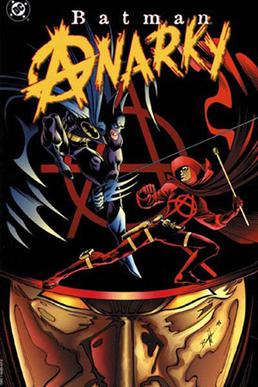
Batman: Anarky is a 1999 trade paperback published by DC Comics. The book collects prominent appearances of Anarky, a comic book character created by Alan Grant and Norm Breyfogle. Although all of the collected stories were written by Alan Grant, various artists contributed to individual stories. Dual introductions were written by the creators - both of whom introduce the character and give insight into their role in Anarky's creation and development.

"The Last Arkham" was a four-part Batman story arc that started the Batman: Shadow of the Bat comic book series in mid-1992. The storyline began in Batman: Shadow of the Bat #1, and finished in Batman: Shadow of the Bat #4. DC Comics later compiled the four issues into a trade paperback in 1995. The comic was written by Alan Grant and drawn by Norm Breyfogle and was responsible for the introduction of several new characters into the Batman universe.
John Costanza is an American comic book artist and letterer. He has worked for both DC Comics and Marvel Comics. He was the letterer during Alan Moore's acclaimed run on Swamp Thing. The bulk of Costanza's art assignments have been for anthropomorphic animal comics and children-oriented material.
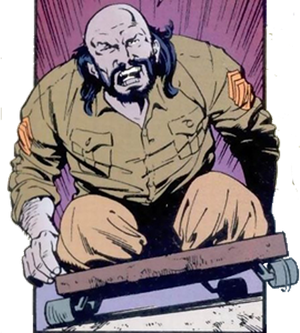
Legs is a fictional character in the DC Comics Universe who appeared as a supporting character in various Batman-related comics during the 80s and 90s. Co-created by writers John Wagner and Alan Grant, and artist Norm Breyfogle, he first appeared in Detective Comics #587.
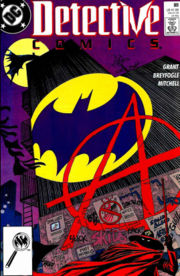
"Anarky in Gotham City" is a two-part comic book story arc which appeared in Detective Comics #608, in November 1989, and was continued the following month in Detective Comics #609. The arc was written by Alan Grant and illustrated by Norm Breyfogle, with editorial oversight by Dennis O'Neil. Coloring by Adrienne Roy and lettering by Todd Klein contributed to the interior artwork.
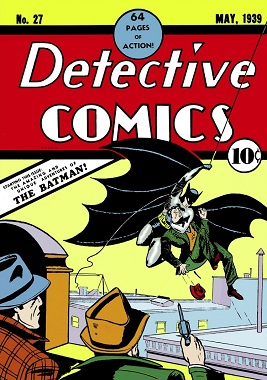
Detective Comics #27 is an American comic book of the Detective Comics anthology series known for debuting the superhero Batman in a featured story called "The Case of the Chemical Syndicate" during the Golden Age of Comic Books. It is considered one of the most important and valuable first appearance debuts from DC Comics alongside Action Comics #1, released the previous year.
The publication history of Anarky, a character appearing in books published by DC Comics, spans various story arcs and comic book series. Co-created by Alan Grant and Norm Breyfogle, he first appeared in Detective Comics #608, as an adversary of Batman. Introduced as Lonnie Machin, a child prodigy with knowledge of radical philosophy and driven to overthrow governments to improve social conditions, stories revolving around Anarky often focus on political and philosophical themes. The character, who is named after the philosophy of anarchism, primarily espouses anti-statism. Multiple social issues have been addressed whenever the character has appeared in print, including environmentalism, antimilitarism, economic exploitation, and political corruption. Inspired by multiple sources, early stories featuring the character often included homages to political and philosophical books, and referenced anarchist philosophers and theorists. The inspiration for the creation of the character and its early development was based in Grant's personal interest in anti-authoritarian philosophy and politics. However, when Grant himself transitioned to the philosophy of Neo-Tech, he shifted the focus of Anarky from a vehicle for socialist and populist philosophy, to rationalist, atheist, and free market-based thought.
Jeremiah Arkham is a fictional supervillain and the head of the Arkham Asylum in DC Comics, created by Alan Grant. Arkham was created in 1992, and slowly "lost his mind" during his time in the Arkham Asylum, subsequently becoming the second Black Mask. Though described as a sadist, Arkham seems to believe his intentions are for the benefit of his patients.



















